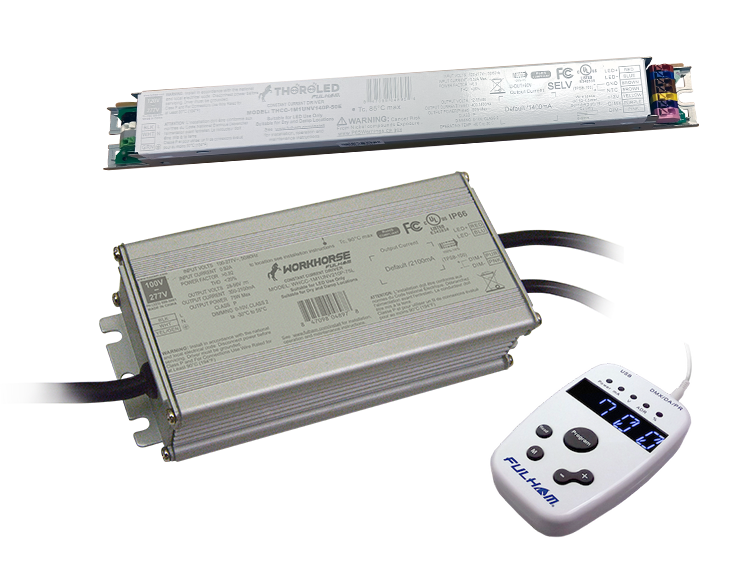The best way to introduce the various types of LED drivers would be to consider two questions:
- What are LED drivers used for?
- How do LED drivers work?
Fulham’s rapidly expanding lines of ThoroLED LED drivers and WorkHorse programmable LED drivers provide reliable, energy-efficient, versatile, and convenient LED solutions for virtually any situation. Constant current and constant voltage LED driver models are available – with DALI, 0-10V, and TRIAC dimming protocol options.
Emergency LED solutions are also available as a Fulham product program under the FireHorse or HotSpot LED brand names. The LED solutions provide backup power (in conjunction with modular batteries) to LED modules within luminaries during power outages.
Power outages are whether the LED modules are supplemental to the primary light source or are part of the primary lighting system.
And the Lumo Series is Fulham’s European LED driver line suited for fixtures sold to European OEMs & distributors or for fixtures exported into Europe.
Fulham’sWorkHorse LED brand of programmable LED drivers offers unmatched flexibility, ease of use, and SKU reduction. “Programmable” means that the output current can be set to meet the in-field or factory application needs.
This flexibility is advantageous when finding creative ways to substitute or replace difficult components to source during component shortages (since electrical components are much harder to come by right now, and are expected to be a challenge through 2023).
It can also mean larger orders of one type of item / one SKU, for economies of scale when ordering in bulk/volume pricing (and lower per- unit pricing), versus buying smaller quantities of dedicated usage LED drivers with relatively more limited, specific purposes.
Fulham’s ThoroLED LED product program relates most often to more general-purpose, non-programmable LED drivers for general lighting. However, some are also suited for specialty applications, such as driving LEDs in refrigeration cases, freezers, Germicidal UV fixtures, etc.
Generallyspeaking, if you know in advance the exact needs and specifications for your luminaire, then ordering a dedicated Fulham ThoroLED LED driver is likely to be more economical than a driver with more built-in versatility, but that is the trade- off.
If your needs change along the way or if you do not use up all the drivers as anticipated, then the remaining unused LED drivers are only suited for specific purposes with that exact output current. By contrast, programmable ones can be repurposed for many other uses, other fixtures, other jobs, other applications, etc, as long as you have the correct power supplies.
The HotSpot Emergency LED product program is also incredibly notable for Fulham; innovations in LED EM solutions have become synonymous with Fulham, only second to the recognition in the market that Fulham has enjoyed for decades with its WorkHorse ballasts.
Another brand name used by Fulham in conjunction with its Emergency systems is the FireHorse brand, FYI.
Last but not least, the Fulham LumoSeries family of LED drivers is specially designed in our European Design Centre to meet the demands of the European market. Fulham LumoSeries LED drivers are built on core engineering design principles for exceptional performance and reliability standards in LED lighting systems.
The highest grade critical components, together with design features for thermal management, ensure excellent reliability. Low ripple designs create flicker-free LED lighting and perfectly smooth dimming.
The simplicity of specification and installation is a vital characteristic of all Fulham LumoSeries LED drivers, hence the wide voltage and current ranges and industry-leading low inrush current.
And lest we forget, Fulham India has expanded its LED driver offering to include several outdoor, wet-rated driver options and its ample assortment of indoor LED drivers for the domestic India market. These are also marketed under the ThoroLED brand. Still, there are India-specific brands, too, such as the IronHorse outdoor LED drivers, RaceHorse LED drivers and WorkHorse Plus LED drivers – exclusively in India.
What is an LED driver?
Now let’s take a step back to ensure that everyone is tracking with all of the terms and explanations on this page. An LED driver itself is an electrical component (a power supply) that is to an LED modules/arrays as an electronic ballast is to a fluorescent tube (or as an induction generator is to an induction lamp, a transformer is to a halogen lamp, etc.).
“Driver” is the name used to refer to the power supply component for LED lighting systems that, together with LED modules/arrays, comprises an LED Light Engine. LED drivers “drive” power to LED modules for optimal light output in different applications and different intensities, with different currents and using different dimming protocols. Each driver’s spec sheet contains standard technical details such as: input voltage range, output voltage range, certifications, output current, dimming range, THD, Power Factor, Sound Rating, Number of Output Channels, etc.
Types of LED Drivers
There are two types of LED drivers: Constant Current LED drivers and Constant Voltage LED drivers. Factors considered when deciding whether to use Constant Current or Constant Voltage LED drivers in your LED fixture design include how the system will be installed, how it will be configured, and overall system efficiency requirements.
With Constant Current, the LED driver feeds a steady current through all LEDs on the module. Since each individual LED requires a specific voltage for the current to flow (known as Vf), the driver must provide enough voltage to equal the total of all the voltages of that module’s LEDs.
Note that while the LED module is designed frequently with all LEDs connected in one continuous serial electrical chain, it is also possible to create branches that split the current flowing through the module. Therefore, it is essential to understand the design of the module’s circuitry and the electrical rating of the LEDs themselves when connecting a Constant Current driver to Constant Current LED modules.
Constant Current architectures offer higher operating efficiency than Constant Voltage but less flexibility in connecting different modules and LEDs to the driver. With Constant Voltage, on the other hand, the LED driver provides a steady voltage supply that enables power to flow through all LEDs connected.
Since any given current flow requires a specific amount of voltage for each individual LED, it is necessary to buffer or regulate the voltage with a resistor (or equivalent component) in line with the connected LEDs.
With proper resistance selection, the series-connected LEDs receive reasonably — never excessive — voltage to regulate the current inflow. The Constant Voltage approach is most commonly used when LED modules vary widely from different installations or product designs.
Programmable vs. Non-Programmable LED drivers
As discussed with Fulham WorkHorse Programmable LED drivers versus ThoroLED general usage LED drivers of dedicated current (above), programmable drivers give users the power to create the right driver for any situation.
Programmable attributes include output current, dimming curve, and lowest dimming percentage, allowing the driver to match the output of existing luminaires or serve as a flexible platform for new luminaire designs. Programmable drivers that are readily available in stock can also substitute for dedicated LED drivers of more limited function when they are harder to come by during electronic component shortages.
Regular LED drivers of specific outputs are specifically and only suited for that one purpose and cannot be changed later. Generally speaking,they are likely to cost less than programmable drivers, but you can also do a lot less with them.
Being in the field, programmable LED drivers allow for SKU reduction and time savings since you don’t know what you’ll encounter on a job site. Having a programmable driver replacement could make the difference between needing to revisit the electrical distributor with precious time or using that time to program a driver. Finish your job and go!
How to install an LED driver
Installation instructions are available with Fulham LED drivers (and a programming guide for the WorkHorse Programmable ones). In a retrofit situation, the driver is likely to fit in the same cavity as the legacy technology was removed from, e.g. the fluorescent ballast cavity after the fluorescent ballast is removed).
Many Fulham drivers are designed with a small overall footprint to be used discreetly in thin or narrow, elegant architectural fixtures.
Quality
As with all of Fulham’s products, our LED driver program is built on the promises of high quality and standing by our items as a 25+ -year old company with a U.S. headquarters and a U.S. warranty.
This can make a material difference compared to buying from unknown foreign sources that most likely haven’t been in the business much longer than their warranty expenses. Additionally, you don’t know how long their business will last or if they will honor their warranty if challenges occur.


